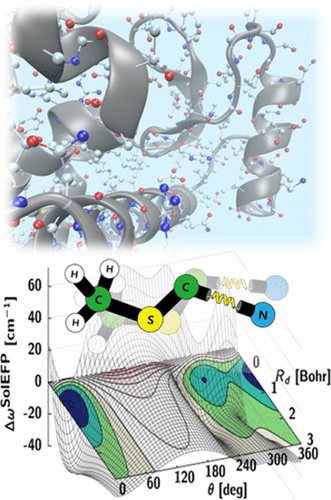
Vibrational Probes: From Small Molecule Solvatochromism Theory and Experiments to Applications in Complex Systems
| author | Minhaeng Cho |
|---|---|
| Homepage | http://cmsd.ibs.re.kr/html/cmsd_en/ |
| journal | Acc. Chem. Res., 2017, 50 (4), pp 968–976 |
| Attachment '1' |
|---|

The vibrational frequency of a chosen normal mode is one of the most accurately measurable spectroscopic properties of molecules in condensed phases. Accordingly, infrared absorption and Raman scattering spectroscopy have provided valuable information on both distributions and ensemble-average values of molecular vibrational frequencies, and these frequencies are now routinely used to investigate structure, conformation, and even absolute configuration of chemical and biological molecules of interest. Recent advancements in coherent time-domain nonlinear vibrational spectroscopy have allowed the study of heterogeneous distributions of local structures and thermally driven ultrafast fluctuations of vibrational frequencies. To fully utilize IR probe functional groups for quantitative bioassays, a variety of biological and chemical techniques have been developed to site-specifically introduce vibrational probe groups into proteins and nucleic acids. These IR-probe-labeled biomolecules and chemically reactive systems are subject to linear and nonlinear vibrational spectroscopic investigations and provide information on the local electric field, conformational changes, site–site protein contacts, and/or function-defining features of biomolecules.
A rapidly expanding library of data from such experiments requires an interpretive method with atom-level chemical accuracy. However, despite prolonged efforts to develop an all-encompassing theory for describing vibrational solvatochromism and electrochromism as well as dynamic fluctuations of instantaneous vibrational frequencies, purely empirical and highly approximate theoretical models have often been used to interpret experimental results. They are, in many cases, based on the simple assumption that the vibrational frequency of an IR reporter is solely dictated by electric potential or field distribution around the vibrational chromophore. Such simplified description of vibrational solvatochromism generally referred to as vibrational Stark effect theory has been considered to be quite appealing and, even in some cases, e.g., carbonyl stretch modes in amide, ester, ketone, and carbonate compounds or proteins, it works quantitatively well, which makes it highly useful in determining the strength of local electric field around the IR chromophore. However, noting that the vibrational frequency shift results from changes of solute–solvent intermolecular interaction potential along its normal coordinate, Pauli exclusion repulsion, polarization, charge transfer, and dispersion interactions, in addition to the electrostatic interaction between distributed charges of both vibrational chromophore and solvent molecules, are to be properly included in the theoretical description of vibrational solvatochromism. Since the electrostatic and nonelectrostatic intermolecular interaction components have distinctively different distance and orientation dependences, they affect the solvatochromic vibrational properties in a completely different manner.
Over the past few years, we have developed a systematic approach to simulating vibrational solvatochromic data based on the effective fragment potential approach, one of the most accurate and rigorous theories on intermolecular interactions. We have further elucidated the interplay of local electric field with the general vibrational solvatochromism of small IR probes in either solvents or complicated biological systems, with emphasis on contributions from non-Coulombic intermolecular interactions to vibrational frequency shifts and fluctuations. With its rigorous foundation and close relation to quantitative interpretation of experimental data, this and related theoretical approaches and experiments will be of use in studying and quantifying the structure and dynamics of biomolecules with unprecedented time and spatial resolution when combined with time-resolved vibrational spectroscopy and chemically sensitive vibrational imaging techniques.
-
Read MoreNo Image
Self-Aggregating Tau Fragments Recapitulate Pathologic Phenotypes and Neurotoxicity of Alzheimer's Disease in Mice
Hugh I. Kimhttps://www.hughkimlab.com/In tauopathy conditions, such as Alzheimer's disease (AD), highly soluble and natively unfolded tau polymerizes into an insoluble filament; however, the mechanistic details of this process remain unclear. In the brains of AD patients, o...Date2023.12.20 Bywebmaster2 Views143 -
Read More

Ultranarrow Mid-infrared Quantum Plasmon Resonance of Self-Doped Silver Selenide Nanocrystal
Kwang Seob Jeonghttps://kwangsjeong.wixsite.com/ksjlab-koreaunivThe infrared quantum plasmon resonance (IR QPR) of nanocrystals (NCs) exhibits the combined properties of classical and quantum mechanics, potentially enabling unprecedented optics. However, research on the development of localized surface ...Date2023.12.20 Bywebmaster2 Views158 -
Read More

Molecular Thermoelectricity in EGaIn-Based Molecular Junctions
Hyo Jae Yoonhttps://hyojaeyoon.wixsite.com/ommlUnderstanding the thermoelectric effects that convert energy between heat and electricity on a molecular scale is of great interest to the nanoscience community. As electronic devices continue to be miniaturized to nanometer scales, thermor...Date2023.12.20 Bywebmaster2 Views140 -
Read More

Perovskite Nanocatalsts Protected by Hermetically Sealing for Highly Bright and Stable Deep-Blue Light-Emitting Diodes
Dong Hoon Choi, Kwangyeol Leehttp://nanolab.korea.ac.kr/Metal–halide perovskite nanocrystals (NCs) have emerged as suitablelight-emitting materials for light-emitting diodes (LEDs) and other practicalapplications. However, LEDs with perovskite NCs undergoenvironment-induced and ion-migratio...Date2023.07.04 Bywebmaster2 Views77 -
Read More

The importance of a charge transfer descriptor for screening potential CO2 reduction on electrocatalysts
Stefan Ringehttps://ringelab.com/It has been over twenty years since the linear scaling of reaction intermediate adsorption energies started to coin the fields of heterogeneous and electrocatalysis as a blessing and a curse at the same time. It has established the possibil...Date2023.07.04 Bywebmaster2 Views62 -
Read More

Resonant Raman-Active Polymer Dot Barcodes for Multiplex Cell Mapping
Sang-Hee Shim, Han Young Woohttps://www.ooml.korea.ac.kr/Resonance Raman spectroscopy is an efficient tool for multiplex imaging because of the narrow bandwidth of the electronically enhanced vibrational signals. However, Raman signals are often overwhelmed by concurrent fluorescence. In this stu...Date2023.05.08 Bywebmaster2 Views107 -
Read More

Decoding the Roles of Amyloid-β (1-42)'s Key Oligomerization Domains toward Designing Epitope-Specific Aggregation Inhibitors
Hugh I. Kimhttps://www.hughkimlab.com/Fibrillar amyloid aggregates are the pathological hallmarks of multiple neurodegenerative diseases. The amyloid-β (1-42) protein, in particular, is a major component of senile plaques in the brains of patients with Alzheimer’s dis...Date2023.05.08 Bywebmaster2 Views316 -
Read More

Flattening bent Janus nanodiscs expands lattice parameters
Kwangyeol Leehttp://ChemNanoscale lattice parameter engineering is a potentially powerful tool for tailoring the electronic properties of nanomaterials. The nascent strain in juxtaposed hetero-interfaces of nanocrystals was recently shown to substantially affect th...Date2023.05.08 Bywebmaster2 Views71 -
Read More

Directing the surface atomic geometry on copper sulfide for enhanced electrochemical nitogen reduction
Kwangyeol Leehttp://nanolab.korea.ac.kr/Understanding catalytic-conversion determinants will blueprint an efficient electrocatalyst design for electrochemical nitrogen reduction. In metal chalcogenide-based catalysts, metal-site nitrogen adsorption initiates nitrogen fixation, and...Date2023.05.08 Bywebmaster2 Views66 -
Read More

High Seebeck Coefficient Achieved by Multinuclear Organometallic Molecular Junctions
Hyo Jae Yoonhttps://hyojaeyoon.wixsite.com/ommlThis paper describes thermoelectric property of molecular junctions incorporating multinuclear ruthenium alkynyl complexes that comprise Ru(dppe)2 (dppe = 1,2-bis(diphenylphosphino)ethane) fragments and diethylnyl aromatic bridging ligands w...Date2023.05.08 Bywebmaster2 Views65 -
Read More

Thermopower in Transition from Tunneling to Hopping
Hyo Jae Yoonhttps://hyojaeyoon.wixsite.com/ommlThe Seebeck effect of molecular junction in a hopping regime or tunneling-to-hopping transition remains uncertain. This paper describes the Seebeck effect in molecular epitaxy films (OPIn where n = 1 – 9) based on imine condensation be...Date2023.05.08 Bywebmaster2 Views69 -
Read More

An Activity-Based Fluorescent Probe for Imaging Fluctuations of Peroxynitrite (ONOO-) in the Alzheimer's Disease Brain
Jong Seung Kimhttp://orgchem.korea.ac.kr/Peroxynitrite (ONOO-) plays a critical role in Alzheimer's disease (AD), and the association between ONOO- and AD is inexplicit. To reveal the ONOO- influxes in AD brains, an activatable activity-based fluorescence probe Rd-DPA3 was rati...Date2023.05.08 Bywebmaster2 Views66 -
Read More

Deep learning for development of organic optoelectronic devices: Efficient prescreening of hosts and emitters in deep-blue fluorescent OLEDS
Dong Hoon Choi and Sungnam Parkhttps://ultrafastspec.wixsite.com/sparkThe highest occupied molecular orbital (HOMO) and lowest unoccupied molecular orbital (LUMO) energies, which are key factors in optoelectronic devices, must be accurately estimated for newly designed materials. Here, we developed a deep lear...Date2023.05.08 Bywebmaster2 Views66 -
Read More

Photocatalytic Superoxide Radical Generator that Induces Pytoptosis in Cancer Cells
Jong Seung Kimhttp://orgchem.korea.ac.kr/In this study, we show that a photocatalytic superoxide radical (O2−•) generator, NI-TA, triggers pyroptosis in cancer cells. NI-TA was designed to take advantage of an intramolecular triplet-ground state splitting energy modulati...Date2023.05.08 Bywebmaster2 Views70 -
Read More

Direct C-H metallation of tetrahydrofuran and application in flow
Heejin Kimhttps://gowithflow.wixsite.com/hkimThe direct C–H metallation of tetrahydrofuran (THF) to generate α-anionic THF is one of the most straightforward methods for the the generation and utilization of α-anionic THF. Here we develop a reaction for the direct met...Date2023.05.08 Bywebmaster2 Views72 -
Read More

Functionalization of Diamine-Appended MOF-Based Adsorbents by Ring Opening of Epoxide: Long-Term Stability and CO2 Recyclability under Humid Conditions
Chang Seop Honghttps://www.immlab.korea.ac.kr/Although diamine-appended metal-organic framework (MOF) adsorbents exhibit excellent CO2 adsorption performance, a continuous decrease in long-term capacity during repeated wet cycles remains a formidable challenge for practical applications...Date2023.05.08 Bywebmaster2 Views56 -
Read More

High Gravimetric and Volumetric Ammonia Capacities in Robust Metal-Organic Frameworks Prepared via Double Postsynthetic Modification
Chang Seop Honghttps://www.immlab.korea.ac.kr/Ammonia is a promising energy vector that can store the high energy density of hydrogen. For this reason, numerous adsorbents have been investigated as ammonia storage materials, but ammonia adsorbents with a high gravimetric/volumetric ammo...Date2023.05.08 Bywebmaster2 Views54 -
Read More

Li-ion Intercalation, Rectification, and Solid Electrolyte Interphase in Molecular Tunnel Junctions
Hyo Jae Yoonhttps://hyojaeyoon.wixsite.com/ommlThis paper describes Li-ion intercalation into pyrenyl terminated self-assembled monolayer (SAM) on gold, inspired from graphite anode in Li-ion battery, and its effect on tunneling performance in molecular junction incorporating the SAM. As...Date2023.05.08 Bywebmaster2 Views55 -
Read More

Thermopower of Molecular Junction in Harsh Thermal Environments
Hyo Jae Yoonhttps://hyojaeyoon.wixsite.com/ommlMolecular junctions can be miniaturized devices for heat-to-electricity conversion application, yet these operate only in mild thermal environments (less than 323 K) because thiol, the most widely used anchor moiety for chemisorption of acti...Date2023.05.08 Bywebmaster2 Views57 -
Read More

Microfluidics-Assisted Synthesis of Hierarchical Cu2O Nanocrystal as C2-Selective CO2 Reduction Electrocatalyst
Heejin Kim, Kwangyeol Leehttp://nanolab.korea.ac.kr/Copper-based catalysts have attracted enormous attention due to their high selectivity for C2+ products during the electrochemical reduction of CO2 (CO2RR). In particular, grain boundaries on the catalysts contribute to the generation of var...Date2023.05.08 Bywebmaster2 Views55
Designed by sketchbooks.co.kr / sketchbook5 board skin